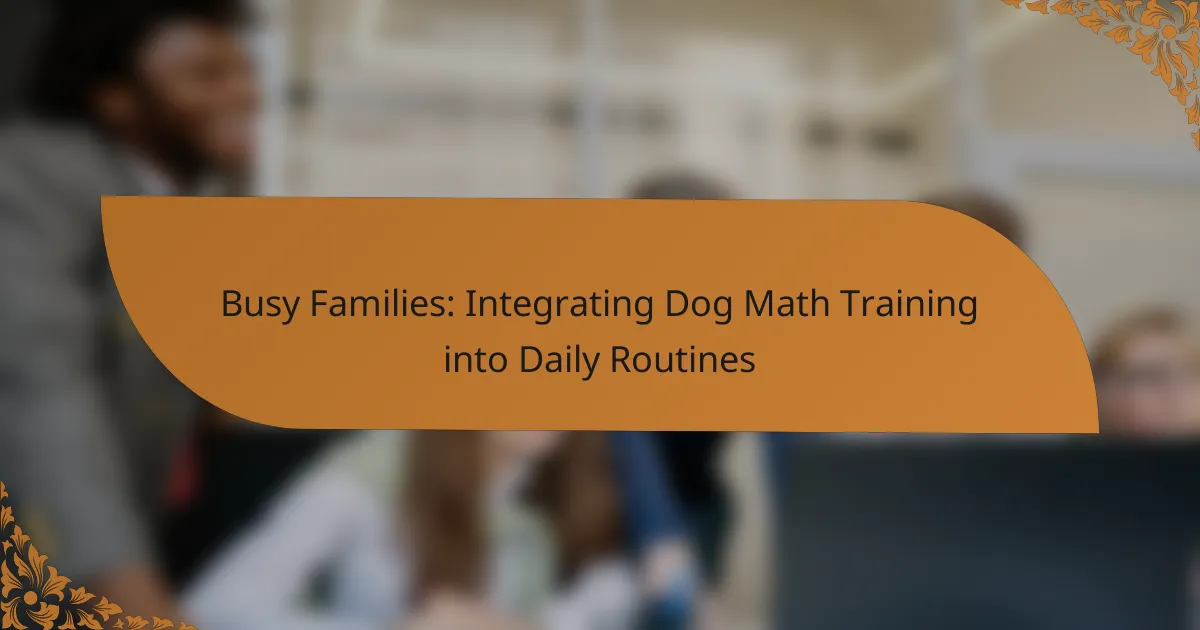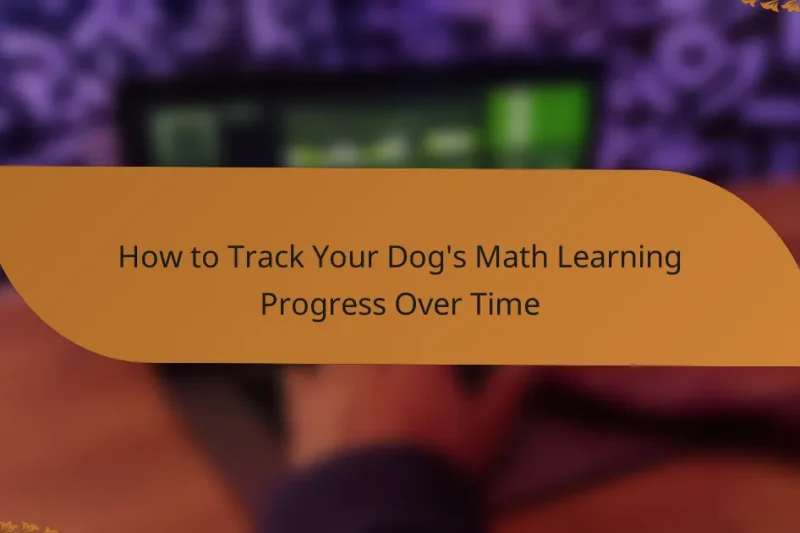Group classes play a vital role in enhancing socialization and learning by providing structured environments for … Group Classes: Socialization, Structure and Learning BenefitsRead more
Dog math training is an innovative approach that enhances your dog's cognitive skills, leading to improved problem-solving abilities and focus. By engaging your pet in mentally stimulating activities, you can foster better obedience and strengthen your bond. Utilizing positive reinforcement, interactive toys, and structured sessions, this training method makes learning basic math concepts both fun and rewarding for your dog.
Busy Families: Integrating Dog Math Training into Daily Routines
Busy families can easily incorporate dog math training into their everyday lives by utilizing brief, focused … Busy Families: Integrating Dog Math Training into Daily RoutinesRead more
Inspiring Transformations: Dogs Overcoming Learning Disabilities and Achieving Success
Dogs with learning disabilities can achieve remarkable transformations through specialized training and supportive environments designed to … Inspiring Transformations: Dogs Overcoming Learning Disabilities and Achieving SuccessRead more
Clicker Training vs. Traditional Methods: Effectiveness, Engagement and Techniques
Clicker training has emerged as a highly effective alternative to traditional training methods, focusing on positive … Clicker Training vs. Traditional Methods: Effectiveness, Engagement and TechniquesRead more
Positive Reinforcement: Techniques, Benefits and Learning Outcomes
Positive reinforcement techniques are powerful strategies designed to encourage desired behaviors by offering rewards or recognition. … Positive Reinforcement: Techniques, Benefits and Learning OutcomesRead more
Technology in Dog Training: Tools, Innovations and Outcomes
Technology has revolutionized dog training by introducing innovative tools and methods that enhance the training experience … Technology in Dog Training: Tools, Innovations and OutcomesRead more
Structured Training Schedule: Consistency, Progress Tracking and Success
A structured training schedule is crucial for efficiently reaching fitness goals by providing a clear framework … Structured Training Schedule: Consistency, Progress Tracking and SuccessRead more
Senior Dogs: Learning Math Concepts and Success Stories
Senior dogs have the remarkable ability to learn math concepts, which can enhance their cognitive skills … Senior Dogs: Learning Math Concepts and Success StoriesRead more
How to Track Your Dog’s Math Learning Progress Over Time
Tracking your dog’s math learning progress is essential for ensuring effective training and development. By utilizing … How to Track Your Dog’s Math Learning Progress Over TimeRead more
How to Adjust Training Techniques Based on Assessment Results
Adjusting training techniques based on assessment results is crucial for optimizing learner outcomes. By analyzing performance … How to Adjust Training Techniques Based on Assessment ResultsRead more
How can dog math training improve your dog's skills?
Dog math training enhances your dog's skills by developing their cognitive abilities, which leads to better problem-solving and focus. This type of training engages your dog mentally, resulting in improved obedience and a stronger bond between you and your pet.
Enhanced problem-solving abilities
Through dog math training, dogs learn to navigate challenges and find solutions, which boosts their problem-solving skills. For example, teaching your dog to associate numbers with treats can encourage them to think critically about how to obtain rewards.
Engaging your dog in math-related tasks, such as counting or simple addition, can stimulate their mind and foster a sense of accomplishment. Regular practice can lead to noticeable improvements in their ability to tackle new challenges.
Increased focus and attention
Math training requires concentration, which helps dogs develop better focus and attention spans. By incorporating fun math exercises into your training routine, you can keep your dog engaged and attentive, reducing distractions during other activities.
For instance, using interactive toys that require your dog to solve math problems can enhance their ability to concentrate. Aim for short sessions of about 5 to 10 minutes to maintain their interest and prevent frustration.
Improved obedience through engagement
Engaging your dog in math training can lead to improved obedience as they learn to respond to commands associated with problem-solving tasks. When dogs are mentally stimulated, they are less likely to exhibit undesirable behaviors, as they are focused on the task at hand.
Incorporating math challenges into obedience training can create a more dynamic learning environment. Use positive reinforcement techniques, such as treats or praise, to encourage your dog and reinforce their good behavior during these exercises.
What methods are effective for dog math training?
Effective methods for dog math training include positive reinforcement techniques, interactive puzzle toys, and structured training sessions. These approaches help dogs learn basic math concepts through engaging and rewarding activities.
Positive reinforcement techniques
Positive reinforcement involves rewarding your dog for correct responses during training. This can include treats, praise, or playtime, which motivates your dog to repeat desired behaviors. For example, if your dog successfully identifies the number of treats in a bowl, immediately reward them to reinforce the behavior.
To implement this method, start with simple tasks, such as counting treats or recognizing shapes. Gradually increase the complexity as your dog becomes more comfortable with the concepts. Avoid using negative reinforcement, as it can lead to anxiety and hinder learning.
Interactive puzzle toys
Interactive puzzle toys are designed to challenge your dog’s problem-solving skills while making learning fun. These toys often require dogs to manipulate pieces to access treats, encouraging them to think critically. Look for toys that allow for varying difficulty levels to keep your dog engaged over time.
When selecting a puzzle toy, consider your dog's size and skill level. Start with simpler puzzles and gradually introduce more complex options. Monitor your dog’s interaction with the toy to ensure they are not becoming frustrated, as this can diminish their interest in learning.
Structured training sessions
Structured training sessions provide a consistent environment for your dog to learn math concepts. Aim for short, focused sessions lasting about 5-10 minutes, which can help maintain your dog's attention. Regular practice is key, so schedule these sessions several times a week.
During training, use clear commands and consistent cues to help your dog understand what is expected. Incorporate a variety of activities, such as counting, sorting, or simple addition tasks, to keep the sessions dynamic. Always end on a positive note, rewarding your dog for their efforts to encourage future participation.
What tools are available for dog math training?
Dog math training can be enhanced with various tools designed to stimulate your dog's cognitive abilities. These tools range from interactive toys to mobile applications and educational literature, each offering unique methods to engage your pet in learning basic math concepts.
Smart toys like CleverPet
Smart toys, such as CleverPet, provide an interactive way for dogs to learn through play. These devices use lights and sounds to encourage dogs to solve puzzles that involve basic math skills, like counting or pattern recognition.
When choosing a smart toy, consider your dog's size and learning style. Some toys are adjustable to increase difficulty, allowing your dog to progress as they master each level. Always supervise your dog during play to ensure safety and engagement.
Mobile apps for training
Mobile apps designed for dog training can be effective tools for math learning. Many apps offer games that challenge dogs to solve problems or perform tasks based on numerical commands.
Look for apps that provide feedback and track your dog's progress. Some popular options include interactive games that reward your dog for correct answers, reinforcing their learning experience. Ensure the app is user-friendly and suitable for your dog's skill level.
Training books and guides
Training books and guides can serve as valuable resources for dog math training. These materials often include step-by-step instructions, exercises, and tips for effectively teaching your dog math concepts.
When selecting a book, choose one that aligns with your training goals and offers practical examples. Look for guides that include positive reinforcement techniques, as these can enhance your dog's learning and make the experience enjoyable for both of you.
How to choose the right dog math training program?
Selecting the right dog math training program involves understanding your dog's unique needs and the qualifications of the trainers. Look for programs that align with your dog's learning style and have positive feedback from other dog owners.
Assessing your dog's learning style
Every dog learns differently, so it's crucial to assess your dog's learning style before choosing a training program. Some dogs may respond better to visual cues, while others might thrive with verbal commands or hands-on guidance.
Observe how your dog reacts to different training methods during initial sessions. For instance, if your dog seems more engaged with interactive games, consider programs that incorporate play into their math training.
Evaluating trainer qualifications
Trainer qualifications can significantly impact the effectiveness of a dog math training program. Look for trainers with certifications from recognized organizations, such as the Association of Professional Dog Trainers (APDT) or the International Association of Animal Behavior Consultants (IAABC).
Additionally, inquire about their experience specifically with math training. A trainer who has successfully taught other dogs similar skills will likely have the techniques and insights necessary to help your dog succeed.
Considering program reviews and testimonials
Reviews and testimonials provide valuable insights into the effectiveness of a dog math training program. Check online platforms, social media, and local community boards for feedback from other dog owners.
Look for programs with consistently positive reviews, especially those highlighting successful outcomes and satisfied clients. A program with a strong reputation is more likely to deliver the results you desire for your dog.
What are the benefits of dog math training in urban areas?
Dog math training offers numerous advantages for dogs living in urban environments, including enhanced mental engagement and improved behavior. In densely populated areas, where space is limited, these training methods can help dogs thrive by providing essential stimulation and socialization opportunities.
Better mental stimulation in confined spaces
Urban living often restricts physical space for dogs, making mental stimulation crucial. Dog math training engages your pet's cognitive abilities through problem-solving tasks and interactive games, which can be done indoors or in small outdoor areas. This type of training can reduce boredom and prevent behavioral issues that arise from lack of activity.
Consider incorporating simple tasks like counting treats or solving puzzles that require your dog to think critically. These activities can be easily adjusted to match your dog's skill level and can be done in short sessions, making them perfect for busy urban lifestyles.
Socialization opportunities with other dogs
Urban areas often have dog parks and community events that provide excellent socialization opportunities. Dog math training can be integrated into these settings, allowing dogs to interact while learning. This interaction not only enhances their social skills but also reinforces positive behaviors when around other dogs.
Look for local meetups or training classes that focus on group activities. Engaging with other dogs in a structured environment can help your pet become more comfortable and confident in social situations, which is essential for their overall development.
Accessible training classes in major cities
Many major cities offer a variety of dog training classes, including those focused on math training techniques. These classes are often designed to accommodate different skill levels and can be found in pet stores, community centers, or through local trainers. Accessibility makes it easier for urban dog owners to find suitable training options.
When selecting a class, consider the trainer's experience and the curriculum offered. Look for classes that emphasize interactive and engaging methods, ensuring your dog receives the best possible training experience while meeting other dogs and their owners.
What are common challenges in dog math training?
Dog math training can be hindered by several challenges that affect a dog's ability to learn and retain information. Understanding these obstacles is essential for effective training and maximizing your dog's potential.
Short attention spans
Many dogs have short attention spans, making it difficult for them to focus on math training sessions. This can lead to frustration for both the dog and the trainer, as the dog may not fully grasp the concepts being taught.
To address short attention spans, keep training sessions brief, ideally lasting no more than 5-10 minutes. Use engaging methods, such as incorporating play or treats, to maintain your dog's interest and motivation throughout the session.
Additionally, consider breaking down complex tasks into smaller, manageable steps. This approach allows your dog to grasp each concept before moving on to the next, enhancing their overall understanding and retention of math skills.













